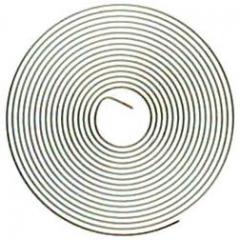Leaderboard
Popular Content
Showing content with the highest reputation on 11/05/17 in all areas
-
2 points
-
Just stumbled across this by pure chance. George Daniels gave a lecture at the 1990 convention of the American Watchmakers-Clockmakers Institute which was video taped and recently digitised It goes for 70 minutes, so I don't know if I will get through it all tonight, but I'm going to give it a go. https://www.hodinkee.com/articles/awci-publishes-rarely-seen-george-daniels-lecture-19902 points
-
Put it in a truing calliper and it looked good. Sent from my iPhone using Tapatalk Pro2 points
-
Indeed, I simply prefer to get intimate with the work on any watch case, and not treat it like a piece of metal, in my experience, each and every watch has soul, and owners have a personal attachment to them, which deserves the personal touch. No complaints in the years I've been refinishing cases, and bracelets, yes, it takes longer than machine polish, but this to me is worth is, I'm not a machine, my customers are prepared to wait that extra time for the personal touch.2 points
-
I just completed cutting my first balance staff on a lathe. All went well on the balance/hairspring side, including undercutting and leaving enough material to make the rivet. On the roller table side however, i cut a smidgen too much. Is there any way to tighten the roller table on or di i need to cut a new staff? I thought shellac on the post would harden and keep the table on. I still need to jacott the pivots, so am i waisting my time? Sent from my iPhone using Tapatalk Pro1 point
-
I don't think it bears too much stressing out about as long as you take some precautions to avoid contamination, change it every ...handful? of months, unless you notice visible contamination, in which case change when you notice, I seem to remember my textbooks teaching to use a just-cleaned screwdriver, something like a 1mm or 1.2mm to transfer from the vial to cup. But I tend to pour out a drop whenever possible, even though it's a bit generous because I just don't like the idea of introducing anything, at risk of contamination to the bottle/vial. Once you've got it in the cup, If you're fairly sure it's not getting contaminated then it's not like there's much else to be concerned about as far as i can see. Another thing I tend to do and this might be slightly unique advice? it's kind of half my own idea, half someone else's. I'm in the habit of taking a generous amount from the cup with my oiler, closing the cup and either place that oil on the top of the closed cup or on the watch near where I'm oiling (such as the top of the gear train bridge near the jewels as an example) and then just draw from that until I'm done and then clean off the mini pool. The original idea behind this was allowing more control over how much oil you draw, even making it convenient to oil a jewel in 2 or 3 draws from the mini pool, so you don't flood the jewels with more oil than is beneficial -- all of which could also be good advice for a beginner. ...I'm getting off track, basically, if you do that the cup is only exposed for a couple of seconds it takes for you to draw once from it, instead of a couple of minutes it might take you to lubricate a section of a watch.1 point
-
I put a drop in the cup and then use it for a couple of movement. But change it frequently. Always a lot of debris and other stuff that gets into the oil. So i recommend that you change it at least once a week. Use a stick or a larger oiler to transfer it from the bottle to the cup. A clean screwdriver is also good. For grease i use a toothpick. If you have a lot oil like 9010 in a cup it makes it harder to get the right amount of oil. At least that is something i have discovered. A drop is enough for 2 -3 movements .1 point
-
I just pour a drop from the bottle that I have as that provides me with more than I need, more or less, and then I wipe the cup with some tissue paper and that's it.1 point
-
i don't work on the cylindar escapments. experts only. carry on - good luck. vin1 point
-
BTW, what kind of steel are you using and what type of gravers? You have to be careful with steel selection and avoid any that undergo work hardening. They sell something called "blued steel" at many places that is typically horrible stuff for what we are doing. Best bet is to get annealed O tool steel and do the gardening and tempering yourself. That way you know what you are getting.1 point
-
Hello, I've been lurking awhile but only recently had the time to start participating. I had a long career in IT and was able to retire early. I wanted to do something I enjoyed doing while not yet feeble. I got my Watchmaking Certification so that I had something to keep me busy and I can do as much or as little as I like. i was a watch collector for many years and realized I'd go broke getting my collection serviced so I'm my own best customer — at least for now.1 point
-
1 point
-
There is plenty of donor movements on Ebay. Only problem is that it takes weeks to arrive from ukraine.1 point
-
Agree with Marc, I go from P220, then move onto the following in this sequence, P240, P380, P600, P800, P1000, then P1500, P2000, then P3000 with water.1 point
-
@bojan1990 I was thinking about your original post and someting occurred to me. You said you moved from P220 to P800 in 1 step. This may be part of your problem as this is a big jump and you will have to keep going with 800 for a long time to remove the marks from 220. Try at least 1 intermediate stage at 400 grit. Alternatively you could do 320 and then 600 before you get to 800. I think this may help.1 point
-
Hi Tim, Nice to hear from you. I was an electronic engineer then sold up at 68. I am a bit old now (nearly 76). My old Dads Certina of 1949 vintage needed repairing. and no one would look at it ! I thought who cares OK, I will fix it myself. Staff EX a scrap watch and had to stone and polish the ends to size. (broken yet the watch has incabloc) clean and lube. I bought a few bits and necessary pieces, Timegrapher 1900 etc: and the Certina gains about 12 Secs a day on the wrist. OK for an old cracker fixed by an amateur. I have fixed all sorts since, Quartz batteries and one O/C Osc. Coil, Speedmaster service and a friends Rolex and he is still my friend. !! JLC pocket watch and next door he has an Omega for me as well to sort out. Two shops locally, one of whom I know personally have asked me to do their repairs...cheap to mid range watches mainly but I cannot take on commercial work. I am not a watchmaker, not insurable, and do not want any serious work. Tim, watch the video`s from Mark Lovick as he is a wonderful watchmaker/engineer. I have learned so much from him and another gentleman in a white coat. Look them up. All good wishes, Mike.1 point
-
My experience with this is mainly pocket watches, in particular, "Waltham" The roller table is a friction fit and once removed for any reason can, on reassembly become loose, especially if removed several times. Reducing the bore size of the roller table is a method of rectification and would have Zero effect on the balance poise. Also when fitting a new staff; even a factory manufactured one, on these old watches it is quite common to secure the balance wheel to the shaft in the way Jdrichard has done. Though a suitable hollow stump under the wheel arm is advisable, to avoid distortion to the balance wheel itself. Sent from my SM-G920F using Tapatalk1 point
-
Thanks Tmuir, I will definitely watch when I get a chance..... I also stumbled across a bit of his life story on Youtube, which was instigated by Roger Smith. I found it an excellent insight and watched the whole lot over 3 days (85 episodes), I bit the bullet and purchased his book Watchmaking which I am very pleased with. There is one of his pocket watches in the British Museum along with a load of Breguets etc......1 point
-
Welcome here, FYIt former or current IT is the most common profession here! In which country did you got certified?1 point
-
I remember these movements and quite good they are to. Sounds nothing to do with oil and escapement. I suggest you take a good look at the large wheel pivots. That is the wheel that runs next to the barrel, the 8 day movements have a powerful spring so the large wheel takes all the wear, it normally shows in the bush or the pivot or both have worn, you need to check both sides, I’ll be very surprised if any of the other train holes or pivots are worn. As it doesn't go its full 8 days tells me the power isn't getting through.1 point
-
As mentioned already I have left this discussion, it's not my duty to educate. Feel free to sandpaper your or your friend' s watches, just.don't don't expect to be told that is right by anyone that does it the correct way.1 point
-
The watch is typical of a late Victorian era 1880-1900 centre seconds chronograph, not a true chronograph because although the centre seconds hand can be stopped with a aid of a lever on the side of the watch, this stops the balance from running thus stopping the centre seconds hand. A true chronograph watch would allow the stopping and resetting of the centre seconds hand without stopping the balance and interfering with the time keeping of the watch but these compared to the watch you have would have been very expensive and beyond the reach of most. The case is probably brass that is nickle plated and in some cases these watches have markings that appear at first glance to be hallmarks and where intended to give the impression that the case was made of silver, much in the same way that E.P.N.S items where often marked at the time.. I would not think that the 13 stamped on the case would refer to the year of manufacture as 1913 I think would be too late a date for this watch.1 point
-
1 point
-
Tren-bucking square watch, not that big. Yeah it's kinda cool. You gotta get that robin-egg blue track suit though.... J1 point
-
Good advice. I'm going to cut a second balance staff this week. Finishing the pivots tonight, as my 4 new 0.2 and 0.4 round and flat carbide gravers are coming in tonight and a really need that round shape to finish the cone on the pivot. Sent from my GT-N5110 using Tapatalk1 point
-
My current collection of watch repair tools. All tools have a special purpose and there are only a few duplicates, where I found a more professional tool. You basically need all these tools to repair watches. Did not include and oils or cleaning solutions. Did not include my ultrasonic cleaner or and timing tools (I use both PC and Tab Software). Did not include my Drummel tool used for case polishing . Sent from my iPhone using Tapatalk Pro1 point
-
There are differences beyond the display size of why someone would pay roughly $3000 versus 225 for a 1900. But for most hobbyists you're never going to notice the difference. I have actually done side-by-side comparison with a Witschi Watch Expert II and the 1000 1900 Chinese machines. Overall for the money the Chinese machines are outstanding but if you're really going to nitpicky about it the Swiss machines have some differences. So let's look at one of the most interesting features I find with the Chinese machines which is who actually makes them? For instance Swiss Timing machine company witschi You can look them up them website they physically exist they have distributors if you had a problem somebody could help you with it. The Chinese machines it's almost impossible to track down where they actually come from. Not that that's a problem because at the price who cares. Then the internal software to run the machines seems to come in two separate types. To explain that I have a image below. So some of the Chinese machines have limited ranges versus the 1900 or 1000. Then if you look at all the different physical sizes their actual characteristics don't really change is not really much advantage of buying a bigger machine. Although as pointed out above if you get the right machine you can use a printer with it. But if you are planning a getting a machine with a printer get it at the time don't plan on adding it later as I've seen the machines without printers don't have the right software to run the printer it's a separate chip. So one of the features missing from the Chinese machine found on the Swiss is frequency mode. Suppose you're doing American pocket watch someplace swap the hairspring or it's missing a timing screw it's running hopelessly fast slow or something not even close to 18,000 beats per hour and frequency mode It will tell you exactly what frequency it's running at.. Other things External audio noise such as an electric shaver in my case. The Chinese machine was showing absolute garbage on the screen the Swiss was working fine. But if the noise is large enough the right frequencies all the timing machines while problems. At work we had problems with one of the cleaning machines so is banished to another room. Then this one I've seen before if the amplitude is too low sometimes the Chinese machine will pick up the wrong part of the waveform giving the impression of a much higher amplitude. So I'm attaching some images. For those of you who like naked electronics like I do the inside of the 1000, 1900 and watch expert II. Then two examples of what the timing machine shows timing of the same watch. Yes if you're clever you can clip both microphones on the same watch at the same time. You don't always get the exact same results because both machines are averaging at slightly different places in the waveform. So you can see the Chinese machine in this case the 1000 is doing very well on a watch that's magnetized. The peculiar sine wave is an indication of a watch that's magnetized. Then we see another example of the extremely low amplitude the Chinese machine is confused.1 point










